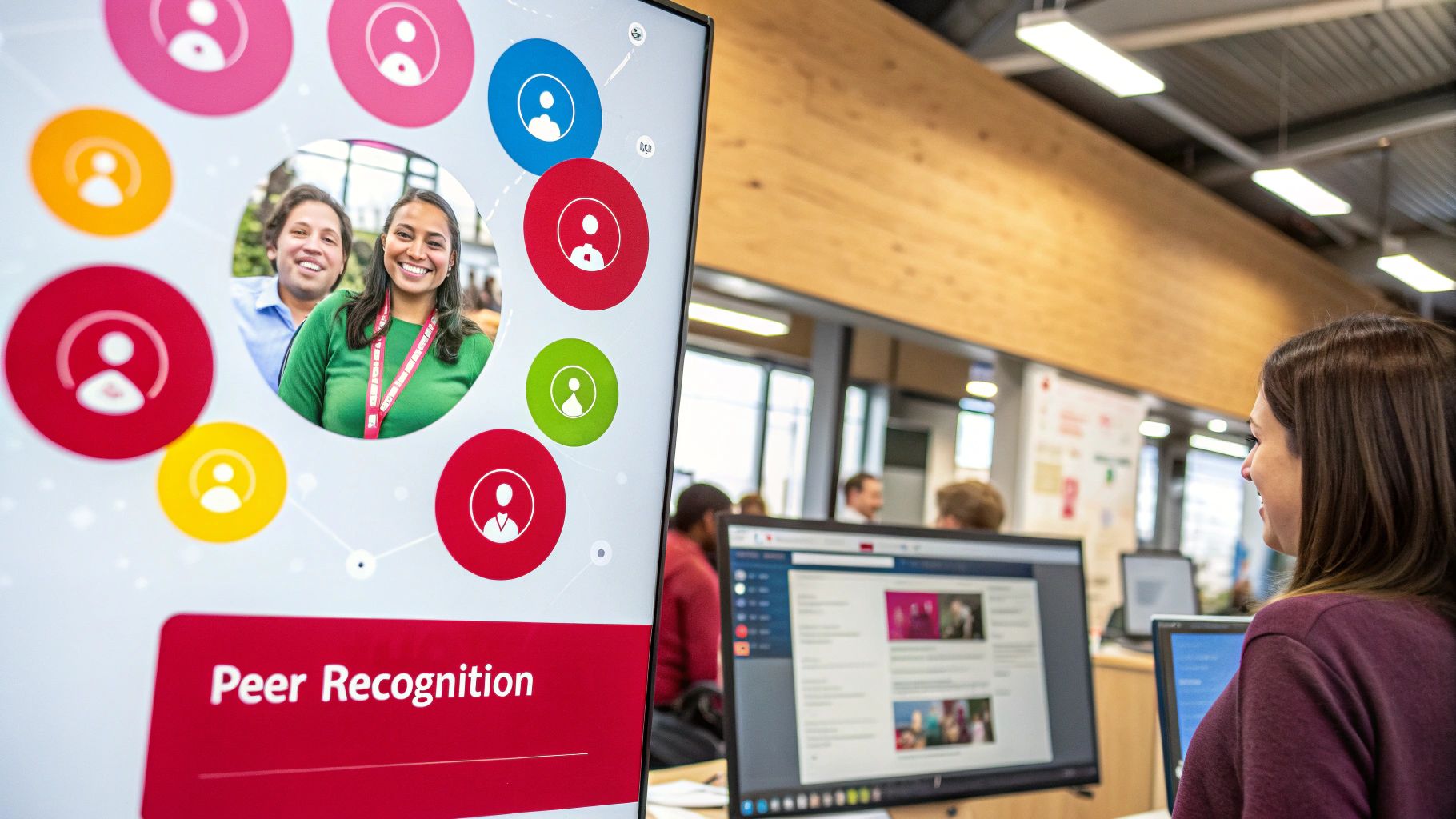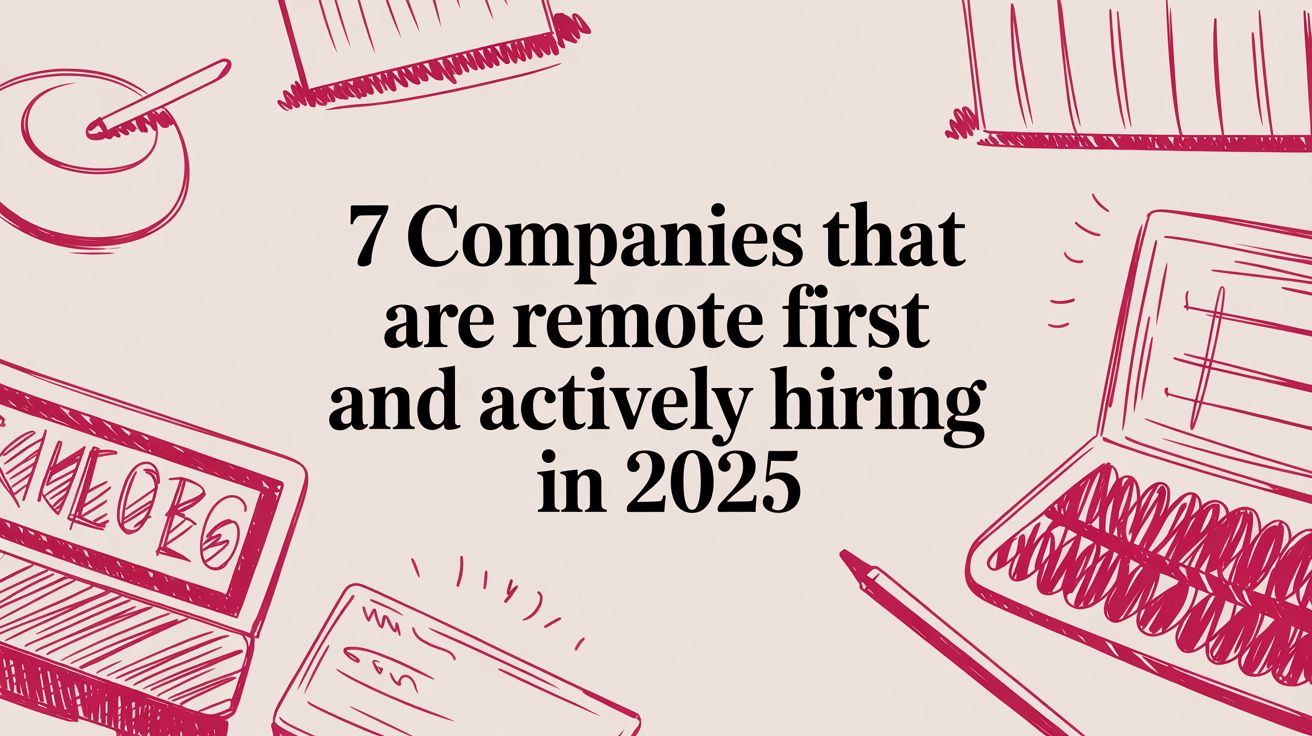7 Remote Employee Engagement Strategies for 2025
Max
Connecting Your Remote Team: Why Engagement Matters
Remote employee engagement drives productivity, collaboration, and retention. This listicle provides seven actionable strategies to boost engagement within your distributed team. Learn how to implement virtual team-building activities, regular check-ins, digital recognition programs, structured onboarding, wellness programs, transparent communication, and remote learning initiatives. These techniques are crucial for creating a thriving remote work environment. Looking for remote talent? Remote First Jobs makes the hiring process smoother with thousands of verified listings and useful resources to power your remote team.
1. Virtual Team Building Activities
Virtual team building activities are structured online events designed to boost remote employee engagement and foster a sense of connection, collaboration, and camaraderie among remote teams. These activities can range from simple icebreakers and virtual coffee chats to more complex problem-solving exercises like virtual escape rooms, all conducted online to bridge the physical distance gap. They play a crucial role in developing stronger bonds within distributed teams and combating the feelings of isolation that can sometimes accompany remote work.

These activities are designed to be interactive and participatory, encouraging active involvement from all team members. They can be facilitated internally by team leaders or by professional third-party organizations specializing in remote team building. The duration can vary greatly, from quick 15-minute energizers to multi-hour events, offering flexibility to accommodate different team schedules and preferences. Moreover, virtual team building activities are adaptable to diverse team sizes and time zones, ensuring inclusivity for globally distributed teams. Looking for some fun and engaging ways to connect with your remote team? Check out this list of creative virtual team building activities to boost morale and collaboration. This resource from Bulby offers some top virtual team building activity options.
Features of Virtual Team Building Activities:
- Synchronous online gatherings: Activities take place in real-time, allowing for immediate interaction.
- Interactive and participatory: Designed to encourage active engagement from all participants.
- Facilitated: Can be led by internal team members or external professionals.
- Flexible duration: Ranging from short exercises to longer events.
- Adaptable to various team sizes and time zones.
Pros:
- Builds interpersonal connections in distributed teams.
- Improves team communication and collaboration.
- Reduces feelings of isolation common in remote work.
- Can boost morale and team spirit.
- Creates shared experiences and memories.
Cons:
- May feel forced or awkward if poorly executed.
- Time zone differences can make scheduling challenging.
- Requires thoughtful planning and facilitation.
- Some employees may find them distracting from ‘real work’.
- Technology barriers can impede participation.
Examples of Successful Implementation:
- GitLab: Virtual coffee chats and team trivia sessions.
- Buffer: Remote “show and tell” where employees share personal interests.
- Zapier: Virtual escape rooms for team problem-solving.
- Microsoft: Remote hackathons combining team building with innovation.
Tips for Effective Virtual Team Building:
- Keep activities brief (30-60 minutes) and engaging.
- Consider asynchronous options for global teams.
- Survey employees about preferred activities.
- Maintain a balance between structured and casual interactions.
- Rotate leadership roles to give everyone a chance to contribute.
When and Why to Use Virtual Team Building:
Virtual team building activities are particularly beneficial for remote teams experiencing communication challenges, low morale, or a lack of connection. They are also valuable for newly formed remote teams as a way to quickly build rapport and establish a positive team dynamic. Regularly incorporating these activities into your remote work strategy contributes significantly to a more engaged and productive workforce.
2. Regular One-on-One Check-ins
One of the most effective strategies for boosting remote employee engagement is implementing regular one-on-one check-ins. This systematic approach involves managers and team leaders scheduling individual meetings with remote employees to provide personalized support, feedback, and coaching. These check-ins create structured touchpoints for addressing concerns, recognizing achievements, and fostering crucial human connection within virtual work environments. This approach ensures that remote employees feel seen, heard, and valued, significantly contributing to their overall engagement and job satisfaction.

These meetings, typically scheduled weekly or bi-weekly, shift the focus from team settings to dedicated individual attention. They facilitate two-way communication, allowing for a combination of work updates and discussions about personal well-being. Crucially, effective one-on-ones involve documenting action items and tracking progress, contributing to a sense of purpose and forward momentum. Learn more about Regular One-on-One Check-ins for additional insights into managing remote teams effectively.
Features of Effective One-on-Ones:
- Consistent, scheduled meetings: Regularity builds rapport and predictability.
- Focused individual attention: Creates a safe space for open communication.
- Two-way communication channels: Encourages dialogue and feedback exchange.
- Combined work/personal discussions: Demonstrates holistic care for the employee.
- Documentation and progress tracking: Promotes accountability and growth.
Pros:
- Builds Trust: Regular, predictable communication fosters a strong manager-employee relationship.
- Deeper Conversations: Provides opportunities for more in-depth discussions than group meetings.
- Proactive Problem Solving: Catches potential issues early before they escalate.
- Accountability & Progress: Drives progress and ensures goals are met.
- Employee Development: Shows investment in individual growth and career progression.
Cons:
- Time Intensive: Can be challenging for managers with large teams.
- Potential for Routine: Requires effort to keep the meetings engaging and avoid feeling like surveillance.
- Scheduling Challenges: Difficult to coordinate across multiple time zones.
- Requires Skilled Managers: Demands strong virtual coaching and communication skills.
- Risk of Dependency: Employees might wait for check-ins to raise concerns.
Examples of Successful Implementation:
- LinkedIn: Utilizes a structured framework focused on career development.
- Shopify: Encourages “life story” sessions to build deeper connections.
- Basecamp: Employs an asynchronous check-in system using written updates.
- Atlassian: Implements “growth conversations” in place of traditional performance reviews.
Tips for Effective One-on-One Check-ins:
- Shared Agenda: Allow both manager and employee to contribute topics.
- Personal Check-in First: Start with personal well-being before diving into work.
- Track Action Items: Review notes and action items from previous meetings.
- Vary the Format: Occasionally try walking meetings or video-off chats.
- Focus on Development: Prioritize growth and support over mere status updates.
Regular one-on-one check-ins deserve a prominent place in any remote employee engagement strategy because they address a fundamental need for connection, support, and growth. By fostering open communication and providing personalized attention, these meetings empower remote employees to thrive, boosting their productivity, morale, and overall contribution to the organization. They have been popularized by thought leaders like Andy Grove (former Intel CEO) in “High Output Management”, Kim Scott’s “Radical Candor” framework, management thought leader Marcus Buckingham, and remote work advocate Darren Murph at GitLab, further solidifying their importance in the modern workplace.
3. Digital Recognition Programs
Digital recognition programs are structured systems that leverage technology to acknowledge and celebrate employee contributions, achievements, and milestones within remote work environments. These programs make recognition visible, consistent, and accessible to distributed teams, fostering a culture of appreciation despite physical distance. They offer a vital way to boost remote employee engagement, a crucial factor for success in today’s increasingly distributed workforce.

These platforms often include features such as public acknowledgment dashboards visible to the entire organization, peer-to-peer recognition capabilities alongside manager-led recognition, integrations with popular communication tools like Slack and Microsoft Teams, point systems or rewards tied to recognition, and data analytics to track recognition patterns across the organization. This data can provide valuable insights into team dynamics and individual performance, further enhancing remote employee engagement initiatives.
Examples of Successful Implementation:
- Bonusly: A peer-to-peer recognition platform used by companies like Hulu and ZipRecruiter, allowing employees to give small bonuses tied to company values.
- Cisco’s “Connected Recognition” program: Integrates monetary rewards with recognition, providing a tangible link between appreciation and compensation.
- Salesforce’s “V2MOM” system: Aligns recognition with company values, ensuring that celebrated behaviors contribute to overall strategic objectives.
- HubSpot’s “Culture Code Champions”: Recognizes employees who exemplify the company’s culture, reinforcing desired behaviors and values.
Tips for Effective Digital Recognition:
- Tie recognition to specific company values and objectives: This ensures recognition is meaningful and reinforces desired behaviors.
- Establish guidelines for meaningful recognition beyond generic praise: Encourage specific examples of contributions rather than simple “good job” messages.
- Combine digital recognition with tangible rewards when appropriate: Gift cards, extra time off, or company swag can amplify the impact of digital recognition.
- Train managers on effective, specific recognition techniques: Managers play a key role in driving a culture of recognition.
- Create regular rituals like weekly appreciation roundups: This helps maintain consistency and visibility.
Pros and Cons:
Pros:
- Makes recognition visible and permanent in virtual environments.
- Facilitates appreciation across time zones and locations.
- Creates a record of accomplishments for performance reviews.
- Democratizes recognition through peer-to-peer options.
- Can boost motivation and reduce turnover.
Cons:
- May feel impersonal compared to in-person recognition.
- Risk of becoming a “checkbox” activity without genuine sentiment.
- Can create competition or feelings of exclusion if poorly implemented.
- Requires consistent participation across leadership to be effective.
- Technology adoption barriers may limit participation.
Why Digital Recognition Deserves a Place on this List:
In a remote work setting, maintaining connection and fostering a sense of belonging can be challenging. Digital recognition programs directly address this challenge by providing a structured, visible, and consistent way to appreciate and celebrate employees. This, in turn, boosts morale, reinforces positive behaviors, and strengthens remote employee engagement – a critical component of any successful remote work strategy. For job seekers, recruiters, and companies navigating the remote landscape, understanding and implementing digital recognition is essential for attracting, retaining, and motivating top talent. This is particularly relevant for tech and digital professionals, global talent agencies, remote workers, programmers, designers, and marketers who often work in dispersed teams. The insights from thought leaders like Adam Grant and remote work experts like Darren Murph and Lisette Sutherland, alongside the emphasis on recognition metrics by organizations like The Great Place to Work Institute, further solidify the importance of digital recognition in the modern workplace.
4. Structured Remote Onboarding
Structured remote onboarding is a crucial element of remote employee engagement. It’s a deliberately designed process for integrating new hires into a remote organization, ensuring they feel welcomed, supported, and equipped to succeed from day one. Unlike traditional in-person onboarding, this approach utilizes digital resources, scheduled interactions, and milestone-based progress tracking to create a consistent and engaging experience regardless of location. This structured approach fosters connections, clarifies expectations, and accelerates the time it takes for new hires to become productive members of the team, ultimately boosting remote employee engagement.

A well-structured remote onboarding process typically includes digital welcome kits and pre-boarding materials, designated onboarding buddies or mentors, structured learning paths with clear timelines, virtual meet-and-greets across departments, regular check-in points with increasing intervals, and self-service knowledge bases and documentation. These elements work together to create a seamless transition for new hires, fostering a sense of belonging and purpose within the organization.
Companies like GitLab, Buffer, Zapier, Automattic, and HubSpot have championed structured remote onboarding and offer excellent examples of its successful implementation. GitLab’s completely documented public onboarding handbook provides a transparent framework, while Buffer’s 45-day structured “Boot Camp” incorporates specific milestones. Zapier’s “Inside Zapier” course, Automattic’s three-week customer support rotation, and HubSpot’s onboarding “Culture Code” certification program all demonstrate innovative approaches to engaging remote employees from the start. Learn more about Structured Remote Onboarding for additional insights and best practices.
Pros of Structured Remote Onboarding:
- Reduces time to productivity: Clear expectations and structured training get new hires up to speed quickly.
- Creates consistent experiences: Ensures all remote employees receive the same level of onboarding regardless of their location.
- Builds social connections and belonging: Fosters a sense of community through virtual meet-and-greets and buddy systems.
- Reduces early-stage turnover and confusion: A structured process minimizes ambiguity and provides support, leading to increased retention.
- Sets clear expectations and success metrics: Defines goals and provides a roadmap for new hires to achieve them.
- Scales efficiently as organizations grow: A well-defined process can be easily replicated and adapted as the company expands.
Cons of Structured Remote Onboarding:
- Requires significant upfront investment to design: Creating comprehensive materials and systems requires time and resources.
- Can feel overwhelming if too much information is provided too quickly: It’s essential to pace the onboarding process effectively.
- Needs regular updates to stay current as organizations evolve: Onboarding materials should be reviewed and updated regularly.
- May struggle to fully convey cultural nuances compared to in-person: While virtual interactions can be effective, they may not fully replicate the richness of in-person connections.
- Requires coordinated effort across multiple departments: Successful onboarding requires collaboration between HR, IT, and various teams.
Tips for Implementing Structured Remote Onboarding:
- Spread onboarding over weeks rather than overwhelming new hires in the first few days.
- Create a digital “source of truth” for all onboarding materials, easily accessible to all new employees.
- Design specific social touchpoints alongside technical training to foster connections.
- Gather feedback throughout the onboarding process to continuously improve and adapt.
- Assign cross-departmental buddies to help new hires build wider networks within the organization.
- Include both asynchronous and synchronous components to accommodate different time zones and working styles.
Structured remote onboarding is more than just a checklist; it’s a strategic investment in remote employee engagement. By prioritizing a comprehensive and well-designed onboarding experience, organizations can cultivate a thriving remote workforce that feels connected, supported, and empowered to contribute meaningfully from the very beginning. This approach is particularly relevant in today’s increasingly distributed work environment, contributing significantly to higher retention rates and increased productivity.
5. Remote Wellness Programs
Remote wellness programs are comprehensive initiatives designed to support the physical, mental, and emotional well-being of remote employees, boosting remote employee engagement and overall satisfaction. These programs are crucial for addressing the unique challenges remote workers face, such as isolation, blurred work-life boundaries, and ergonomic concerns. Unlike traditional office settings, remote work often lacks built-in social interaction and can lead to feelings of disconnect. This is where a well-structured wellness program can make a significant difference. They achieve this through a combination of resources, activities, and benefits delivered virtually, ensuring accessibility for all team members regardless of location.
How They Work:
Remote wellness programs operate by offering a variety of virtual services and resources. These can include:
- Mental health support: Subscriptions to platforms like Calm or Headspace, access to therapists through services like Modern Health, and dedicated “Conflict Resolution Channels” like those at Hubspot can provide confidential support.
- Virtual fitness: Companies like Peloton Corporate and ClassPass offer corporate wellness solutions. Organized virtual fitness classes, step challenges, and company-wide fitness competitions can foster a sense of community and encourage healthy habits.
- Ergonomic support: Home office stipends, like those offered by Automattic, allow employees to create comfortable and healthy workspaces. Ergonomic assessments can further prevent long-term physical issues.
- Structured breaks & “no meeting” days: Designated “no meeting” days, like LinkedIn’s “InDay,” and encouraging regular breaks throughout the workday help maintain a healthy work-life balance and reduce burnout.
- Stress management & resilience training: Workshops and online resources equip employees with coping mechanisms for stress and promote overall resilience.
- Digital mindfulness & meditation sessions: Guided meditation sessions, like those offered in Asana’s “Asana Reset” program, offer accessible tools for stress reduction and mental clarity.
Why Remote Wellness Programs Deserve a Place in Your Strategy:
In a remote-first world, prioritizing employee well-being is paramount. Remote wellness programs are not merely a perk; they are a strategic investment in your workforce. These programs directly contribute to increased remote employee engagement by demonstrating that the organization cares about the whole person, not just their output. This leads to improved morale, reduced burnout, and increased productivity. Further, they can contribute to lower healthcare costs and absenteeism by proactively addressing potential health concerns. Building a culture that values wellness can also be a powerful tool for attracting and retaining top talent.
Pros and Cons:
Pros:
- Addresses the whole-person health needs of remote workers
- Reduces burnout and stress-related productivity loss
- Demonstrates organizational care beyond work output
- Can lower healthcare costs and absenteeism
- Creates shared experiences through wellness challenges
- Helps establish healthier remote work habits
Cons:
- Participation may vary widely across the organization
- Measuring ROI and effectiveness can be challenging
- May feel intrusive if poorly implemented
- One-size-fits-all approaches often fail to meet diverse needs
- Requires ongoing resources and refreshing to maintain engagement
Actionable Tips for Implementation:
- Survey employees: Understand their specific needs and preferences before implementing any program.
- Offer variety: Create both synchronous (live classes, group meditations) and asynchronous (on-demand videos, pre-recorded workshops) options to cater to different schedules and preferences.
- Train managers: Equip managers to recognize signs of burnout in remote contexts and support their team members effectively.
- Establish clear boundaries: Promote a healthy work-life balance by setting clear expectations around workday end times and encouraging employees to disconnect.
- Integrate wellness check-ins: Incorporate brief wellness check-ins into regular team meetings to normalize conversations about well-being.
- Partner with digital platforms: Leverage existing digital wellness platforms for scalable solutions and access to a wider range of resources.
When and Why to Use This Approach:
Remote wellness programs are essential for any organization with a remote workforce. They are particularly beneficial when:
- Transitioning to remote work: Help employees adapt to the challenges of remote work and establish healthy habits from the start.
- Addressing burnout and low morale: Proactively mitigate these issues by providing resources and support for employee well-being.
- Building a strong remote culture: Foster a sense of community and connection among remote team members through shared wellness activities.
Learn more about Remote Wellness Programs and how they can contribute to a healthier and more engaged remote workforce. By prioritizing employee well-being, organizations can cultivate a thriving remote culture and achieve sustainable success.
6. Transparent Communication Systems: The Glue of Remote Employee Engagement
Transparent communication systems are the backbone of successful remote employee engagement. They’re the strategic frameworks that ensure clear, consistent, and accessible information flows throughout a distributed organization. These systems combat the dreaded information silos that can plague remote teams by creating structured channels, establishing documentation practices, and defining communication norms. This ensures all remote employees have equitable access to company information, decisions, and context, regardless of their physical location or time zone. This equitable access is crucial for fostering a sense of belonging and promoting remote employee engagement.
How Transparent Communication Works:
The core principle is simple: make information readily available and accessible to everyone. This involves moving away from relying solely on in-person conversations and implicit knowledge towards documented processes and open communication channels. It’s about creating a “single source of truth” where employees can find answers to their questions, understand company decisions, and gain insight into the bigger picture. This fosters a culture of trust and empowers remote employees to work more autonomously.
Features of Effective Transparent Communication Systems:
- Comprehensive Internal Documentation and Knowledge Bases: Think internal wikis, style guides, FAQs, and process documentation. This creates a searchable, accessible history of organizational knowledge.
- Default-to-Open Information Sharing Policies: Encourage a culture where information is shared openly by default unless there are specific confidentiality concerns.
- Regular All-Hands or Town Hall Meetings with Recorded Options: These meetings provide opportunities for company-wide updates and Q&A sessions. Recording them ensures accessibility for different time zones and schedules.
- Designated Channels for Different Types of Communication: Using tools like Slack or Microsoft Teams, dedicate specific channels for different projects, departments, or types of communication (e.g., announcements, social, technical support).
- Clear Decision-Making Frameworks and Visibility: Document how decisions are made and make the rationale behind those decisions transparent.
- Asynchronous Updates Alongside Real-Time Communications: Balance real-time meetings with asynchronous updates via email, project management tools, or internal blogs to cater to different working styles and time zones.
Pros:
- Reduces information inequity between in-office and remote workers, fostering a stronger sense of belonging and inclusion.
- Creates a searchable, accessible history of organizational knowledge, saving time and resources.
- Minimizes misunderstandings and duplicated work by providing clarity and context.
- Builds trust through openness about company direction and decision-making.
- Enables more autonomous and informed decision-making by empowering employees with the information they need.
- Reduces the need for unnecessary meetings by providing information proactively.
Cons:
- Requires discipline to maintain documentation consistently.
- May initially feel inefficient to document extensively.
- Can create information overload without good organization and information architecture.
- Some topics remain necessarily confidential, requiring careful consideration of what to share openly.
- Cultural and organizational changes may be needed for successful adoption.
Examples of Successful Implementation:
- GitLab’s public handbook: Documents virtually all processes, providing a comprehensive resource for employees and the public.
- Basecamp’s “Shape Up” method: Employs transparent project cycles with clear deadlines and progress updates.
- Buffer’s open salary policy and financial transparency: Fosters trust and equity by openly sharing salary information.
- Notion’s company wiki approach to team knowledge: Leverages Notion’s versatile platform for internal documentation and knowledge sharing.
- Zapier’s internal documentation-first approach: Prioritizes documentation for all processes and workflows.
Tips for Implementing Transparent Communication:
- Establish a single source of truth for company information (e.g., an internal wiki or knowledge base).
- Create templates for consistent documentation.
- Rotate responsibility for meeting notes and summaries.
- Implement a regular cadence of company updates (e.g., weekly newsletters, monthly all-hands meetings).
- Train new hires in documentation practices from day one.
- Use tools that support both synchronous and asynchronous work (e.g., Slack, Microsoft Teams, project management software).
Why Transparent Communication is Essential for Remote Employee Engagement:
In a remote work environment, where physical proximity and informal communication are limited, transparent communication systems become vital for building trust, fostering collaboration, and ensuring everyone feels connected and informed. By providing equitable access to information and fostering a culture of openness, organizations can significantly boost remote employee engagement and create a more inclusive and productive work environment. This is particularly important for attracting and retaining top talent in today’s competitive remote job market. This approach, popularized by companies like GitLab and Buffer, and championed by remote work advocates like Matt Mullenweg (creator of WordPress), is rapidly becoming a best practice for successful remote organizations.
7. Remote Learning & Development Initiatives
Remote learning and development initiatives are structured programs designed to foster continuous skill growth, career advancement, and knowledge sharing in virtual environments. These initiatives are crucial for remote employee engagement as they demonstrate a company’s investment in its remote workforce, boosting morale and retention. They adapt traditional professional development to remote contexts by leveraging digital learning platforms, virtual mentorship, skill-sharing sessions, and self-directed growth opportunities with clear progression paths. This approach recognizes that continuous learning is essential in today’s rapidly evolving job market and empowers remote employees to stay ahead of the curve.
How it Works:
Remote learning and development initiatives utilize a blend of digital tools and virtual engagement strategies. Digital learning platforms offer on-demand courses and resources accessible anytime, anywhere. Virtual mentorship and coaching programs connect remote employees with experienced professionals for personalized guidance. Skill-sharing sessions, often conducted as virtual lunch-and-learns, allow employees to share their expertise and learn from each other. Learning stipends empower employees to pursue self-directed development aligned with their career goals. Some companies even offer virtual rotation programs across departments, enabling employees to gain experience in different areas of the business. Digital certification and badging systems provide a way to recognize and reward learning achievements.
Features:
- Digital learning platforms with on-demand courses (e.g., Udemy for Business, Coursera)
- Virtual mentorship and coaching programs
- Remote lunch-and-learn or skill-sharing sessions
- Learning stipends for self-directed development
- Virtual rotation programs across departments
- Digital certification and badging systems
Examples of Successful Implementation:
- Salesforce’s Trailhead: This digital learning platform offers gamified learning paths with badges and certifications, fostering continuous learning and skill development.
- PwC’s “New World, New Skills”: This multi-billion dollar initiative focuses on digital upskilling to equip employees for the changing world of work.
- LinkedIn Learning allotments: Many companies, including Microsoft, provide employees with access to LinkedIn Learning’s vast library of online courses.
- HubSpot Academy: HubSpot uses its own platform for internal training and certification programs, demonstrating the effectiveness of in-house solutions.
- Shopify’s “Dev Degree” program: This innovative program combines work experience with formal education, providing a pathway for employees to earn a degree while working at Shopify.
Pros:
- Demonstrates investment in remote employee growth and retention, enhancing remote employee engagement.
- Helps build cross-functional knowledge and relationships.
- Creates clear paths for advancement in remote environments.
- Supports continuous skill development as jobs evolve.
- Leverages diverse expertise across distributed teams.
- Can be more accessible and cost-effective than in-person training.
Cons:
- Digital fatigue can reduce engagement with online learning.
- Harder to practice new skills without in-person guidance.
- May lack the immersive nature of in-person training.
- Requires self-discipline and time management.
- Risk of unequal access based on time zones or roles.
Tips for Implementation:
- Create learning paths aligned with career progression.
- Schedule protected learning time in employee calendars to encourage participation.
- Develop internal experts as virtual instructors to leverage existing knowledge within the organization.
- Mix synchronous (live) and asynchronous (on-demand) learning opportunities to cater to different learning styles.
- Establish peer learning circles around common interests to foster collaboration and knowledge sharing.
- Recognize and celebrate learning achievements publicly to reinforce the value of continuous development.
When and Why to Use This Approach:
Remote learning and development initiatives are essential for any organization with a remote workforce. They are particularly beneficial for companies undergoing digital transformation, experiencing rapid growth, or operating in industries with constant change. By investing in the development of their remote employees, companies can improve remote employee engagement, boost retention, and build a highly skilled and adaptable workforce. This approach is crucial for creating a thriving remote work culture where employees feel valued and empowered to grow their careers. It directly contributes to a more engaged and productive remote team, making it a vital component of any successful remote work strategy.
7 Remote Engagement Strategies Compared
| Strategy | Implementation Complexity 🔄 | Resource Requirements ⚡ | Expected Outcomes 📊 | Ideal Use Cases 💡 | Key Advantages ⭐ |
|---|---|---|---|---|---|
| Virtual Team Building Activities | Medium: requires facilitation and planning | Moderate: time for events, tech platforms | Improved team cohesion, communication, morale | Distributed teams needing connection and collaboration | Builds interpersonal bonds; boosts morale; adaptable |
| Regular One-on-One Check-ins | Medium-High: scheduling & coaching skills | High: manager time and attention | Stronger trust, accountability, early issue detection | Managers managing remote teams for personalized support | Deep individual engagement; progress tracking |
| Digital Recognition Programs | Medium: platform setup and management | Moderate: tech tools and participation | Increased motivation, visible appreciation, reduced churn | Organizations seeking consistent recognition culture | Democratizes praise; record achievements; scalable |
| Structured Remote Onboarding | High: design, coordination, and updates | High: content creation, cross-team effort | Faster productivity, better integration, lower turnover | Remote companies onboarding new employees | Consistent experience; builds belonging; scalable |
| Remote Wellness Programs | Medium-High: program design and resources | Moderate-High: wellness tools and incentives | Reduced burnout, improved health, employee satisfaction | Companies addressing remote work health challenges | Supports whole-person wellbeing; reduces attrition |
| Transparent Communication Systems | High: culture shift and documentation upkeep | Moderate: tools and discipline | Enhanced access to info, trust-building, less miscommunication | Distributed orgs needing info equity | Reduces silos; builds trust; supports autonomy |
| Remote Learning & Development Initiatives | Medium-High: platform and program design | Moderate-High: content, mentoring, stipends | Skill growth, retention, career advancement | Organizations investing in continuous remote growth | Accessible learning; clear paths; fosters expertise |
Building a Thriving Remote Work Culture
Fostering genuine remote employee engagement isn’t just a trend; it’s the cornerstone of success in today’s distributed workforce. From virtual team-building activities that spark camaraderie to structured remote onboarding that sets new hires up for success, the strategies outlined in this article provide a roadmap to creating a thriving remote work environment. By prioritizing regular one-on-one check-ins, robust digital recognition programs, remote wellness initiatives, transparent communication systems, and remote learning and development opportunities, you invest in your team’s well-being and empower them to reach their full potential. Mastering these approaches translates directly into increased productivity, higher retention rates, and a stronger, more connected team, even across geographical boundaries. This ultimately builds a company culture where employees feel valued, supported, and truly engaged in their work, no matter where they are located.
Prioritizing remote employee engagement is paramount for attracting and retaining top talent in today’s competitive landscape. Are you ready to connect with skilled remote professionals seeking engaging and supportive remote work environments? Discover a world of opportunities at Remote First Jobs, the premier platform connecting top remote talent with companies committed to thriving remote work cultures.


